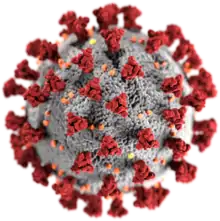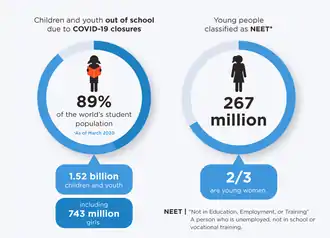Impact of the COVID-19 pandemic on children
A systematic review notes that children with COVID-19 have milder effects and better prognoses than adults.[1] However, children are susceptible to multisystem inflammatory syndrome, a rare but life-threatening systemic illness involving persistent fever and extreme inflammation following exposure to the SARS-CoV-2 virus.[2]
| Part of a series on the |
| COVID-19 pandemic |
|---|
 |
|
|
|
As a vulnerable population, children and youth may be affected by the COVID-19 pandemic in many other domains, including education, mental health, safety, and socioeconomic stability; the infection of the virus may lead to separation or loss of their family. As with many other crises, the COVID-19 pandemic may compound existing vulnerabilities and inequalities experienced by children.[3][4][5]
Education

School closures
By the end of March 2020, UNESCO estimated that over 89% of the world's student population was out of school or university due to closures aimed at mitigating the spread of COVID-19.[6] This raised serious concerns regarding the social, economic, and educational impacts of protracted school closures on students.[7][8][9][10] In addition, school closures disproportionately affect children from low-income or minority families, children with disabilities, and young women, due to disparities in access to distance education, unequal distribution of increased child-care and domestic responsibilities, and the fact that school subsidized meal programs and vaccinations are cornerstones of child healthcare for many families.[5] For example, school closures during the 2014–2016 Ebola outbreak in West Africa increased school dropouts, rates of child labor, violence against children, and teen pregnancies.[11]
Impact on student life
A comprehensive global study (Aristovnik et al., 2020) provides systematic meaningful insights into students’ satisfaction and perception of different aspects of their lives during the first wave of the pandemic, including their opinions on the immediate and distant future. The study found that teaching staff and universities’ public relations offered students the most important support at the university during the pandemic. On the other hand, the lack of computer skills and the perception of a relatively higher workload prevented students from perceiving a higher performance while adapting to the ‘new normal’; namely, education from a distance.
During the lockdown, students primarily raised concerns about their future professional career[12] and study issues and were mainly bored, anxious, and frustrated. They also changed some of their hygienic behaviours such as regularly wearing masks and washing hands, and daily routine habits like leaving home and shaking hands.
While the role of both hospitals and universities appears to be positive, governments and banks did not meet the students’ expectations during the pandemic.
Socio-demographic (and geographic) factors also played an important role in the students’ perception of different aspects of academic work/life. The empirical results suggest that the transition from onsite to online lectures due to the COVID-19 crisis had a stronger effect on males, part-time students, undergraduate students, applied sciences students, students with a lower living standard, and students from less developed regions (in Africa and Asia), while the pandemic generally had a greater effect on students who were female, full-time, undergraduate and had financial problems with respect to their emotional life and personal circumstances. The results also demonstrate that more hopeful and less bored students, students who were more satisfied with their academic work/life, social science students, students with a better living standard (with a scholarship and/or the ability to pay the overall costs of study), and those who were studying in Europe showed greater satisfaction with the role and measures of their university during the COVID-19 crisis.[13]
Impact on most at-risk groups
Child safety is at risk during the pandemic. Children who are living in unsanitary and crowded conditions are particularly at risk.[14] Youth – especially young women, indigenous peoples, migrants, and refugees – face heightened socioeconomic and health impacts and an increased risk of gender-based violence due to social isolation, discrimination and increased financial stress. They are also more prone to child marriage as families seek ways to alleviate economic burdens.[15][16][17][18]
Although reports of child abuse in the US declined by an average of 40.6% from April 2019 to April 2020, child welfare advocates suggest that this drop is an under-reporting artifact secondary to the closure of schools and daycare centers, where most reports of child abuse are made.[19][20] The Rape, Abuse & Incest National Network reported in April 2020 that for the first time, over half of the victims calling their National Sexual Assault Hotline for help were minors.[21]
Impact on young migrants
This global crisis is exacerbating existing vulnerabilities and inequalities experienced by young people, amplified in humanitarian contexts where fragility, conflict, and emergencies have undermined institutional capacity and where there is limited access to services.[3][22] Particularly affected are: young migrants; young people who are internally displaced or refugees; young people living in poor, high-density urban areas; young people without a home; young people living with disabilities; and those living with HIV. Young people separated from, unaccompanied, or left behind by migrant working parents face higher risks of exploitation, violence, and mental health issues, as well as poor access to health services and protection.[3][22][23]
Vaccines
As of September 22, 2020, no vaccine trials were being conducted on children under the age of 18 years.[24]
Sources
![]() This article incorporates text from a free content work. Licensed under CC BY-SA IGO 3.0 License statement/permission on Wikimedia Commons. Text taken from Explainer: How COVID-19 Impacts Women and Girls, Young Women and Girls, UN Women.
This article incorporates text from a free content work. Licensed under CC BY-SA IGO 3.0 License statement/permission on Wikimedia Commons. Text taken from Explainer: How COVID-19 Impacts Women and Girls, Young Women and Girls, UN Women.
References
- Ludvigsson JF (June 2020). "Systematic review of COVID-19 in children shows milder cases and a better prognosis than adults". Acta Paediatrica. 109 (6): 1088–1095. doi:10.1111/apa.15270. PMC 7228328. PMID 32202343.
- Ahmed M, Advani S, Moreira A, et al. (September 2020). "Multisystem inflammatory syndrome in children: a systematic review". EClinicalMedicine: 100527. doi:10.1016/j.eclinm.2020.100527. ISSN 2589-5370. PMC 7473262. PMID 32923992. S2CID 221494176.
- "COVID-19: Working with and for young people". www.unfpa.org. May 2020. Retrieved 5 June 2020.
- Harvard Health Publishing (15 May 2020). "Coronavirus outbreak and kids". Harvard Health. Retrieved 5 June 2020.
- Armitage R, Nellums LB (May 2020). "Considering inequalities in the school closure response to COVID-19". Lancet Global Health. 8 (5): e644. doi:10.1016/S2214-109X(20)30116-9. PMC 7195275. PMID 32222161.
- "Covid-19 school closures around the world will hit girls hardest". UNESCO. 31 March 2020. Retrieved 24 June 2020.
- Loukas A, Roalson LA, Herrera DE (2010). "School connectedness buffers the effects of negative family relations and poor effortful control on early adolescent conduct problems". Journal of Research on Adolescence. 20 (1): 13–22. doi:10.1111/j.1532-7795.2009.00632.x.
- Foster CE, Horwitz A, Thomas A, Opperman K, Gipson P, Burnside A, et al. (October 2017). "Connectedness to family, school, peers, and community in socially vulnerable adolescents". Child and Youth Services Review. 81: 321–331. doi:10.1016/j.childyouth.2017.08.011. PMC 6128354. PMID 30202142.
- Psacharopoulos G, Patrinos HA (2018). "Returns to investment in education: a decennial review of theglobal literature". Education Economics. 26 (5): 445–458. doi:10.1080/09645292.2018.1484426. hdl:10986/30154. S2CID 158496991.
- Cooper H, Nye B, Charlton K, Lindsay J, Greathouse S (September 1996). "The Effects of Summer Vacation on Achievement Test Scores: A Narrative and Meta-Analytic Review". Review of Educational Research. 66 (3): 227–268. doi:10.3102/00346543066003227. S2CID 145635039.
- Harwin, Alex (20 October 2020). "COVID-19's Disproportionate Toll on Class of 2020 Graduates". Education Week. Retrieved 22 January 2021.
- Aristovnik A, Keržič D, Ravšelj D, Tomaževič N, Umek L (October 2020). "Impacts of the COVID-19 Pandemic on Life of Higher Education Students: A Global Perspective". Sustainability. 12 (20): 8438. doi:10.3390/su12208438.
 Text was copied from this source, which is available under a Creative Commons Attribution 4.0 International License.
Text was copied from this source, which is available under a Creative Commons Attribution 4.0 International License. - "Impact of Covid-19 on Children". 8 May 2020.
- "UN Secretary-General's policy brief: The impact of COVID-19 on women | Digital library: Publications". UN Women. Retrieved 24 June 2020.
- UN Women. (19 September 2019). Families in a changing world / UN Women. New York. ISBN 978-1-63214-156-9. OCLC 1120137550.
- Women, U. N. "How COVID-19 impacts women and girls". interactive.unwomen.org. Retrieved 24 June 2020.
- "Gender equality matters in COVID-19 response". UN Women. Retrieved 24 June 2020.
- "Is the U.S. coronavirus lockdown hiding a surge in child abuse?". NBC News. Retrieved 28 July 2020.
- "Advocates concerned over drop in reported child abuse cases in NYC". FOX 5 NY. 10 June 2020. Retrieved 28 July 2020.
- "Child abuse risk remains concern amid continued COVID financial, social strain". ABC News. Retrieved 4 January 2021.
- CDC (11 February 2020). "Coronavirus Disease 2019 (COVID-19)". Centers for Disease Control and Prevention. Retrieved 5 June 2020.
- UNICEF Office for the Eastern Caribbean Area (1 July 2020). "The Impact of COVID-19 on Migrant Children in Trinidad and Tobago" (PDF).
- Zimmerman, Carl (21 September 2020). "A COVID-19 Vaccine May Not Arrive Until Fall 2021". The New York Times. Retrieved 22 September 2020.